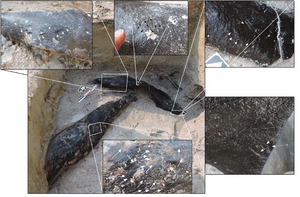Kalambo structure facts for kids

Shaping marks on the upper surfaces and on the underlying tree trunk (arrows indicating cutmarks)
|
|
| Location | Kalambo Falls |
|---|---|
| Region | Lake Tanganyika |
| Length | >141.3 cm |
| History | |
| Builder | Homo heidelbergensis? |
| Material | Wood |
| Founded | c. 474,000 BCE |
| Periods | Early Stone Age |
| Cultures | Acheulean |
| Site notes | |
| Excavation dates | 2019 |
| Archaeologists | Barham, L., Duller, G.A.T., Candy, I. et al. |
The Kalambo structure is an amazing discovery! It's a very old wooden structure, made of two pieces of wood. Scientists also found other wooden tools nearby. This structure was found at Kalambo Falls in Zambia. It's the oldest wooden structure ever found, about 476,000 years old! This means it was built long before modern humans (Homo sapiens) even existed. Scientists used a special method called luminescence dating to figure out its age.
Contents
How the Kalambo Structure Was Found
Scientists have been digging at Kalambo Falls for a long time. In the 1950s and 1960s, they found some old wooden pieces. But it was hard to tell if early humans had made them. The wood was very old and had changed a lot over time.
Then, in 2019, something incredible happened. A team found the Kalambo structure and other tools. They found them near the Kalambo River. The structure itself was in an area called BLB5. It was found with other tools from the Acheulean culture. This culture is known for its stone tools.
Finding such old wood was very unusual. Wood usually rots away quickly. Geoff Duller, one of the scientists, explained why this wood survived. High water levels and fine dirt covered the structure. This helped to keep the wood safe for hundreds of thousands of years.
What the Kalambo Structure Looks Like
The Kalambo structure is made of two wooden logs. These logs come from a tree called large-fruited bushwillow (Combretum zeyheri). The logs fit together like puzzle pieces. One log has a special U-shaped cut, called a notch. This notch allows it to connect to the other log at a right angle.
The smaller log is about 141.3 centimeters (55.6 inches) long. Its ends are shaped to be narrower. Geoff Duller thinks the structure might have been part of a platform. This platform could have been used as a walkway. It might have kept food or firewood dry. Or maybe it was a base for building a shelter.
This discovery is very important. It suggests that early humans at Kalambo Falls might have lived in one place. This idea challenges what many scientists thought. They used to believe that Stone Age hominins (early human ancestors) always moved around.
How the Logs Were Shaped
The notch in the top log shows signs of being made with tools. It looks like it was scraped and cut. Scientists also found hints that fire might have been used. This was discovered using a method called infrared spectroscopy.
The log underneath also has marks. These are V-shaped cuts and scratches. They are found in the middle and near the narrow end. This also suggests that tools were used to scrape the wood.
Scientists used luminescence dating to find the age of the logs. They are about 476,000 years old. Another test, called carbon dating, confirmed this. It showed the wood was much older than 50,000 years.
Another similar wooden log was found before. It also had tapered ends and a notch. It was found at Kalambo Falls too. But at that time, scientists weren't sure if it was made by early humans.
Besides the structure, other wooden tools were found. These include a wedge and a digging stick. These tools are a bit younger than the structure. They are between 390,000 and 324,000 years old.
Why the Kalambo Structure Is Important
Archaeologists like Larry Barham led the team that found the structure. He believes wooden tools might have been very common in the Stone Age. But wood usually decays, so we don't find many of them.
Barham and his team think that wooden and stone tools developed together. They see a link between the Kalambo structure and later inventions. For example, the idea of hafting came later. Hafting is when different parts are joined to make one tool.
The time when the Kalambo structure was built was a good time for forests. The area around the Kalambo River was covered in trees. Barham's team thinks there was a lot of food and resources. The water levels were always high. Building raised structures helped early humans live above the wet ground. This made it a good place for them to stay for a long time.
This discovery happened more than 100,000 years before Homo sapiens appeared. No human remains have been found at Kalambo Falls. So, scientists don't know exactly which early human group built it. However, a 300,000-year-old skull of Homo heidelbergensis was found in another part of Zambia. This suggests they might have been the builders.

